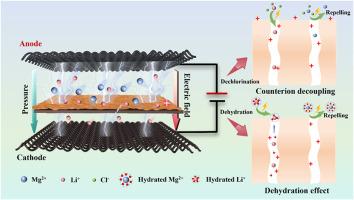Electro-assisted functional nanofiltration membrane for enhancing Li+ enrichment and Li+/Mg2+ separation
IF 9
1区 工程技术
Q1 ENGINEERING, CHEMICAL
引用次数: 0
Abstract
The electric field-assisted nanofiltration process exhibited considerable promise for the selective separation of monovalent and divalent ions, owing to the capability to precisely regulate ion migration behavior. In this study, polyethyleneimine (PEI)-modified ZIF-8 (P-ZIF-8) nanoparticles were incorporated into a polyamide matrix to fabricate a composite nanofiltration membrane with a surface enriched in positive charge density. Driven by the external electric field, the membrane effectively facilitated the dehydration of Li+, accelerated the mass transfer rate of monovalent ions, and provided an effective electric field compensation effect. At an operating pressure of 4 bar and a current of 8 mA, the membrane exhibited a Li+/Mg2+ separation factor of 272.9, with a Mg2+ rejection rate of 98.7 % and a Li+ permeability of 150 %, surpassing most previously reported performances. Moreover, the electric field-assisted strategy was successfully extended to other monovalent/divalent ion systems, the separation factors of 90.4 for Na+/Mg2+ and 18.8 for K+/Mg2+, respectively. Molecular dynamics (MD) simulations further elucidated that electric field-induced ion dehydration, coupled with enhanced counterion decoupling, synergistically facilitated the efficient separation of Li+ and Mg2+. Overall, this work presented a viable approach for achieving high Mg2+ rejection and Li + enrichment by coupling functionalized nanofiltration membranes with an electric field-assisted strategy, offering both theoretical insights and practical guidance for advancing electro-driven nanofiltration technologies in complex ion separation scenarios.

电辅助功能纳滤膜增强Li+富集和Li+/Mg2+分离
电场辅助纳滤工艺由于能够精确调节离子迁移行为,在选择性分离单价和二价离子方面表现出相当大的前景。本研究将聚乙烯亚胺(PEI)修饰的ZIF-8 (P-ZIF-8)纳米颗粒掺入聚酰胺基质中,制备表面正电荷密度富集的复合纳滤膜。在外加电场的驱动下,膜有效地促进了Li+的脱水,加快了单价离子的传质速率,并提供了有效的电场补偿效果。在4 bar的工作压力和8 mA的电流下,该膜的Li+/Mg2+分离系数为272.9,Mg2+截除率为98.7%,Li+渗透率为150%,超过了之前报道的大多数性能。此外,电场辅助策略成功地推广到其他单价/二价离子体系,Na+/Mg2+和K+/Mg2+的分离因子分别为90.4和18.8。分子动力学(MD)模拟进一步阐明了电场诱导的离子脱水,加上增强的反离子解耦,协同促进了Li+和Mg2+的有效分离。总的来说,这项工作提出了一种可行的方法,通过电场辅助策略耦合功能化纳滤膜来实现高Mg2+截除率和Li +富集,为在复杂离子分离场景中推进电驱动纳滤技术提供了理论见解和实践指导。
本文章由计算机程序翻译,如有差异,请以英文原文为准。
求助全文
约1分钟内获得全文
求助全文
来源期刊

Journal of Membrane Science
工程技术-高分子科学
CiteScore
17.10
自引率
17.90%
发文量
1031
审稿时长
2.5 months
期刊介绍:
The Journal of Membrane Science is a publication that focuses on membrane systems and is aimed at academic and industrial chemists, chemical engineers, materials scientists, and membranologists. It publishes original research and reviews on various aspects of membrane transport, membrane formation/structure, fouling, module/process design, and processes/applications. The journal primarily focuses on the structure, function, and performance of non-biological membranes but also includes papers that relate to biological membranes. The Journal of Membrane Science publishes Full Text Papers, State-of-the-Art Reviews, Letters to the Editor, and Perspectives.
 求助内容:
求助内容: 应助结果提醒方式:
应助结果提醒方式:


